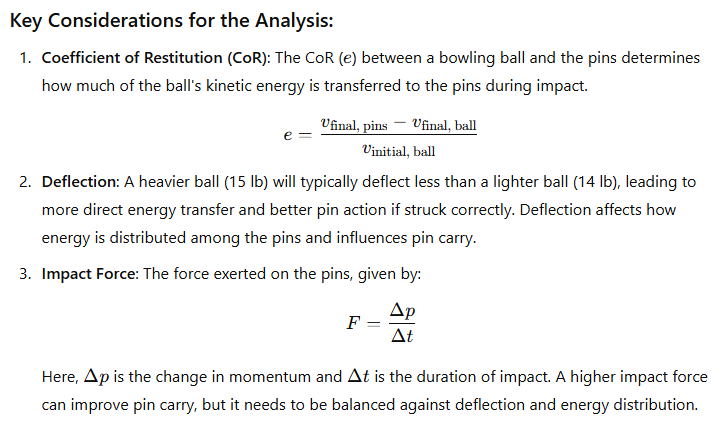Your cart is currently empty!
Choosing the Best Bowling Ball Weight
The Physics Behind Your Decision
When it comes to bowling, choosing the right ball weight can be a game-changer. But how do you decide what pound ball to use? The answer lies in understanding some basic physics concepts that impact your ball’s speed, momentum, and pin carry. In this post, we’ll explore the physics behind different bowling ball weights to help you make an informed decision.
Disclaimer: This article is meant for entertainment and informational purposes only. I’m not a physicist, and the insights shared here are based on practical observations, basic physics principles, and other trusted sources. Whether you’re a serious bowler or just looking to boost your knowledge, I hope this helps add a bit of scientific fun to your next game.
Key Physics Principles

Exploring Ball Weights and Speed
Given the general understanding that a lighter ball (e.g., 12 lb) can be thrown faster than a heavier ball (e.g., 16 lb), you can analyze the trade-off between speed and mass using these equations:

Interpretation
- Momentum: The 16 lb ball has more momentum, implying that it can transfer force more effectively to the pins with less deflection.
- Kinetic Energy: Although the lighter 12 lb ball has more kinetic energy due to its higher speed, this doesn’t always translate into better pin action, as energy transfer efficiency depends on how well it interacts with the pins.
Engineering Considerations
- Pin Action and Deflection: Lighter balls at higher speeds can achieve comparable energy but might deflect more, reducing pin carry.
- Impact Duration: Δt could vary slightly due to ball weight, with heavier balls potentially experiencing longer contact times and more efficient energy transfer.
14 lb ball at 16mph vs 15 lb ball at 15mph
To determine whether throwing a 14 lb ball at 16 mph or a 15 lb ball at 15 mph is more beneficial, we need to dive deeper into impact dynamics, including energy transfer, deflection, and pin carry potential. We will incorporate the coefficient of restitution (CoR), which describes how effectively energy is transferred during a collision between the ball and the pins.


Deflection and Pin Carry:
- 14 lb ball: Although it has higher energy transfer due to greater speed, it may deflect more, especially when hitting off-center. This could lead to less consistent pin carry.
- 15 lb ball: Its higher momentum means it deflects less, which can be crucial for better pin carry, especially on slightly off-center hits. This makes it more consistent in transferring energy directly to the pins.
Final Assessment:
- 14 lb Ball at 16 mph: Offers more kinetic energy and transfers more energy to the pins, potentially resulting in powerful pin action when hitting the pocket cleanly. However, it might deflect more, which could reduce pin carry consistency on off-center hits.
- 15 lb Ball at 15 mph: Provides slightly less kinetic energy but greater momentum, leading to less deflection and more reliable pin carry. This ball may perform better for maintaining energy through the pins and carrying hits that are not perfectly on target.
Conclusion:
The choice between a 14 lb ball at 16 mph and a 15 lb ball at 15 mph depends on the player’s consistency and style:
- 14 lb ball: Best for those who can hit the pocket consistently and want maximum energy transfer.
- 15 lb ball: More beneficial for players who need better deflection control and pin carry on less-than-perfect hits.
Ultimate Conclusion
Ultimately, the choice between a 14 lb and a 15 lb bowling ball—or any weight for that matter—comes down to more than just physics. While understanding momentum, kinetic energy, and pin action can guide your decision, the most important factor is how comfortable you feel with the ball in your hand. Comfort and confidence often translate to better consistency and accuracy on the lanes.
Keep in mind that while physics can offer insight into potential advantages, your unique style, physical attributes, and skill level play a significant role in performance. To get the most out of your game, consider consulting a professional bowling coach who can assess your technique and recommend the best ball weight for your needs.
At the end of the day, trust your own experience, experiment with different weights if needed, and choose the ball that feels right for you. Armed with this knowledge, you’re one step closer to making informed decisions that enhance your bowling performance and enjoyment.
If you’re interested in finding the correct bowling ball weight based on these formulas, feel free to contact me. I can input your details into my algorithm to help you choose the perfect ball weight for your game.
